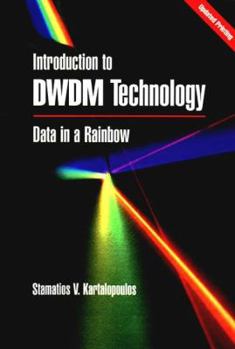Introduction to Dwdm Technology: Data in a Rainbow
Select Format
Select Condition 
Book Overview
"Companies and research labs worldwide are racing to develop Dense Wavelength Division Multiplexing (DWDM) technology, a far-reaching advancement in the fiber optical communications field. To help you keep pace with these latest developments, this all-in-one resource brings you a clear, concise overview of the technology that is transporting and processing vast amounts of information at the speed of light. Until now, no book offered a practical introduction to DWDM advances.
INTRODUCTION TO DWDM TECHNOLOGY will help you learn all the essentials for this emerging field:
* Principles of physics underlying optical devices
* Optical components needed to design optical and DWDM systems
* Coding and decoding techniques used in optical communications
* Overview of DWDM systems
* State-of-the-art research trends
Complete with four-color illustrations to show how devices work, this comprehensive book provides an invaluable discussion of DWDM basics necessary for practicing electrical engineers, optical systems designers, technical managers, and undergraduate students in optical communications.
Go to
htttp: //www.ieee.org/organizations/pubs/press/Kartfm.pdf for a complete Table of Contents and a look at the Introduction. You can check out Chapter 5, ""Optical Demultiplexers"" by clicking on
http: //www.ieee.org/organizations/pubs/press/KartCh5.pdf
About the Author
Stamatios V. Kartalopoulos is currently on the staff of the Optical Networks Group of Lucent Technologies, Bell Labs Innovations, formerly known as AT&T. His research interests include ATM and SONET/SDH systems, ultrafast pattern recognition, IP and DWDM, access enterprise systems, local area networks, fiber networks, satellite systems, intelligent signal processing, neural networks, and fuzzy logic. He holds several patents of which six patents (and six pending) are in communications and optical communications systems."
Sponsored by:
IEEE Communications Society
INTRODUCTION TO DWDM TECHNOLOGY will help you learn all the essentials for this emerging field:
* Principles of physics underlying optical devices
* Optical components needed to design optical and DWDM systems
* Coding and decoding techniques used in optical communications
* Overview of DWDM systems
* State-of-the-art research trends
Complete with four-color illustrations to show how devices work, this comprehensive book provides an invaluable discussion of DWDM basics necessary for practicing electrical engineers, optical systems designers, technical managers, and undergraduate students in optical communications.
Go to
htttp: //www.ieee.org/organizations/pubs/press/Kartfm.pdf for a complete Table of Contents and a look at the Introduction. You can check out Chapter 5, ""Optical Demultiplexers"" by clicking on
http: //www.ieee.org/organizations/pubs/press/KartCh5.pdf
About the Author
Stamatios V. Kartalopoulos is currently on the staff of the Optical Networks Group of Lucent Technologies, Bell Labs Innovations, formerly known as AT&T. His research interests include ATM and SONET/SDH systems, ultrafast pattern recognition, IP and DWDM, access enterprise systems, local area networks, fiber networks, satellite systems, intelligent signal processing, neural networks, and fuzzy logic. He holds several patents of which six patents (and six pending) are in communications and optical communications systems."
Sponsored by:
IEEE Communications Society
Format:Hardcover
Language:English
ISBN:0780353994
ISBN13:9780780353992
Release Date:December 1999
Publisher:Wiley-IEEE Press
Length:276 Pages
Weight:1.20 lbs.
Dimensions:0.8" x 6.3" x 9.4"
Customer Reviews
2 ratings
Introduction to DWDM Technology
Published by Thriftbooks.com User , 24 years ago
It was a pleasant surprise to read this book. I decided to buy the book despite a 3 star rating because I needed to update myself quickly.First I found the book full of nicely done and colorful diagrams that are easy to understand. The author succeeds in explaining fairly complex topics in simple enough words that someone like me with background in science and engineering but work in another field can grasp the concepts quite fast.The book covers a wide range of the latest technologies so it is definitely a useful reference book for people looking to understand optical engineering. It may be too simple for readers who are already knowledgeable in optics. In that sense, I can actually see disappointment by them. But for managers and investors who want to know the subject enough to appreciate the technology-- but not to be an engineer or designer in the field-- this is very useful.I used to write "introductory" books in another technical field with good review from managers and technicians. This book has accomplished that goal for me.
A good overview of the WDM underlying principles
Published by Thriftbooks.com User , 25 years ago
I found the text book very usefull as an overview of the technology. Good and at the point description of the components/hardware used for optical communication. The author has an excellent understanding of the physics governing the technology. Some typos can be found through the text, the author should have the text reviewed more carefully. I recommend the book to anyone who wants to know "how things work".






